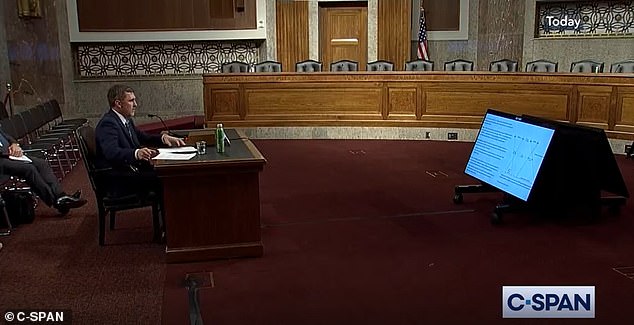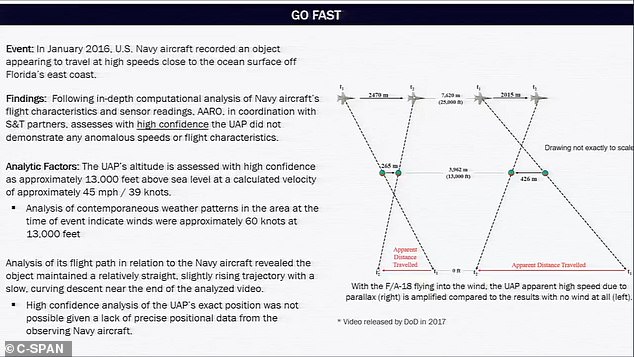A Pentagon office told Congress Tuesday that the department has cracked the case of the famous UFO spotted by a Navy jet over the Atlantic in 2015.
The unknown object was captured in the grainy, black and white ‘Go Fast’ video taken by a fighter pilot’s head-up display, with him saying: ‘Ohhh, go it!’
Dr Jon Kosloski, director of the Defense Department’s All-Domain Anomaly Resolution Office (AARO), testified under oath in a hearing held by the Armed Service Committee, saying the infrared UFO video showed nothing more than ‘a trick of the eye.’
He attributed the UFO’s apparent high-speed skimming over the ocean to an optical illusion, called ‘parallax,’ but the office did not identify the object otherwise.
Kosloski only discussed the UFO‘s apparent speed, citing unspecified information contradicting public meteorological data.
‘The Go Fast,’ Dr Kosloski testified under oath, ‘looks like an object flying very fast over the water, very close to the water.’
However, climate scientists, meteorological data, veteran Navy witnesses and even a computer simulation continue to cast doubt on the validity of the government’s ‘parallax’ theory.
‘I don’t think everything is being taken into account,’ former US Navy lieutenant and F/A-18F fighter pilot Ryan Graves said of AARO’s new explanation.
‘If the AARO office actually spoke with the pilots that were involved in that incident, they would know the objects were part of a larger formation of objects, and thus very anomalous to be operating 300 miles off the coast and within 50 miles of a US aircraft carrier.’


The ‘Go Fast’ footage was made public two years after pilots captured it from the USS Theodore Roosevelt off the east coast of Florida.
Lt Graves told NBC News after the AARO hearing that the ‘Go Fast’ UFO was just one of multiple swarms of UFOs cited by aircrew with the USS Roosevelt as a flight safety risk, including the equally famous ‘Gimbal’ UFO video.
But Kosloski assured the court that there was a reasonable explanation for what the pilots saw that day.
The Pentagon official said a geospatial intelligence analysis, using trigonometry, what ‘very carefully done.
‘We assess with high confidence that the object is not actually close to the water, but is rather closer to 13,000 feet,’ he continued.
The speed of the F/A-18 Navy fighter jet that recorded the ‘Go Fast’ video, Kosloski argued, created the illusion that the object was traveling at an inexplicably high speed.




‘As the platform is flying and capturing the object, if it is closer to the platform at a higher altitude,’ Dr Kosloski told the Senate, ‘a trick of the eye called ‘parallax’ makes it look like the object is moving much faster.’
‘Analysis of contemporaneous weather patterns in the area at the time of the event,’ according to one of the AARO director’s slides, which were presented under oath, ‘indicate winds were approximately 60 knots at 13,000 feet.’
Crucially, however, Navy pilot witnesses heard in the GIMBAL video, filmed in the same area roughly 15 minutes after the ‘Go Fast’ video, stated that the wind at their altitude of about 25,000 feet was then blowing ‘120 knots to the west.’
One computer simulation, created by noted UFO skeptic Mick West, found that the ‘Go Fast’ object would have been going significantly faster than 40 mph when taking this wind speed into account.
The skeptic’s most conservative run of the simulation would have the UFO traveling at 100 knots or 115 mph.
Public wind speed data from the time and place of the ‘Go Fast’ sighting confirms this analysis collated from multiple systems by the European Centre for Medium-Range Weather Forecasts.
The data is publicly available through the organization’s ERA5 reanalyzed climate dataset, which is used by researchers to obtain reliable, global, hour-by-hour weather information.


ERA5 data proximate to the date, region and elevations of the ‘Go fast’ UFO episode were obtained by the DailyMail.com in September of 2023 by a PhD climate researcher who wished to remain anonymous.
When this ERA5 data pointing toward a 100-knot ‘Go Fast’ UFO was shown to Josh Semeter of NASA’s UAP advisory panel, the Boston University professor told the DailyMail.com via email: ‘Yes, a 100-knot object ground speed is within the range of plausible solutions.’
‘But based on uncertainties in wind vectors and trajectory model,’ Semeter added, ‘a speed below 40 knots cannot be ruled out.’
Regardless of the object’s speed, Lt Graves noted that the object was not only still a UFO but that its presence with ‘a whole fleet’ of other UFOs in restricted US airspace remains not only a mystery but a serious flight safety concern.
‘I would argue that […] specifically the ‘Go Fast’ video itself was never really interesting because it was ‘going fast,” Lt Graves said.
‘The pilot certainly didn’t say that, nor did they name the video,’ the veteran Navy fighter pilot added. ‘If anything, the Pentagon simply debunked their own naming for that video.’

